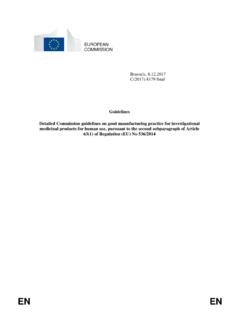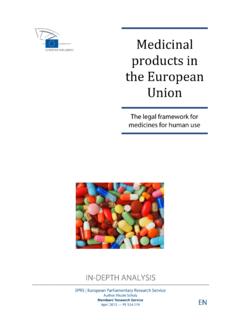Transcription of Guideline on the environmental risk assessment of medicinal …
1 30 Churchill Place Canary Wharf London E14 5EU United Kingdom An agency of the European Union Telephone +44 (0)20 3660 6000 Facsimile +44 (0)20 3660 5555 Send a question via our website European Medicines Agency, 2018. Reproduction is authorised provided the source is acknowledged. 15 November 2018 1 EMEA/CHMP/SWP/4447/00 Rev. 1 2 Committee for medicinal Products for human Use (CHMP) 3 Guideline on the environmental risk assessment of 4 medicinal products for human use 5 Draft 6 Draft agreed by Safety Working Party October 2018 Adopted by CHMP for release for consultation 15 November 2018 Start of public consultation 1 December 2018 End of consultation (deadline for comments) 30 June 2019 7 This Guideline replaces Guideline on the environmental risk assessment of medicinal products for 8 human use (EMEA/CHMP/SWP/4447/00 corr 2) . 9 10 Comments should be provided using this template.
2 The completed comments form should be sent to 11 Keywords environmental risk assessment , ERA, human medicinal products, PBT 12 Guideline on the environmental risk assessment of medicinal products for human use EMEA/CHMP/SWP/4447/00 Rev. 1 Page 2/48 Guideline on the environmental risk assessment of 13 medicinal products for human use 14 Table of contents 15 Executive summary .. 4 16 1. Introduction (background) .. 4 17 2. Scope and legal basis .. 4 18 3. General Principles .. 5 19 Overview of the risk assessment and PBT assessment .. 5 20 Risk assessment .. 6 21 PBT assessment .. 7 22 Finalization of risk and PBT assessment .. 7 23 General considerations .. 7 24 Total residue approach .. 7 25 Test guidelines .. 8 26 Publicly available data .. 8 27 4. Risk assessment .. 8 28 Phase I Risk assessment .. 8 29 Phase II Risk assessment .. 13 30 Determination of physico-chemical properties, fate and ecotoxicity.
3 13 31 Trigger values for soil, groundwater, and secondary poisoning .. 17 32 Surface water .. 18 33 Sediment .. 24 34 Sewage Treatment Plant .. 27 35 Groundwater .. 28 36 Soil .. 31 37 Secondary poisoning .. 35 38 Tailored assessment for active substances with a specific mode of action .. 36 39 Antibiotics .. 36 40 Endocrine active substances (EAS) .. 37 41 5. PBT 39 42 PBT Screening .. 40 43 Definitive PBT assessment .. 40 44 PBT criteria .. 40 45 Performing the PBT 41 46 6. Search and evaluation of data .. 44 47 Data Search .. 44 48 Evaluation of studies .. 44 49 Guideline on the environmental risk assessment of medicinal products for human use EMEA/CHMP/SWP/4447/00 Rev. 1 Page 3/48 7. Labelling and risk mitigation .. 44 50 8. Scientific advice from the EMA or national competent authorities .. 46 51 9. Structure of the ERA report.
4 46 52 10. References .. 46 53 Definitions .. 47 54 55 Guideline on the environmental risk assessment of medicinal products for human use EMEA/CHMP/SWP/4447/00 Rev. 1 Page 4/48 Executive summary 56 The purpose of this Guideline is to describe the assessment of the potential environmental risks and 57 hazards of human medicinal products (HMP). It specifies the scope and legal basis for assessment . It 58 outlines general considerations and the recommended step-wise procedure of assessment . The general 59 outline of the environmental Risk assessment Report is included, and for products for which risks 60 cannot be excluded, this Guideline outlines the possible precautionary and safety measures. 61 1. Introduction (background) 62 It is mandatory for the dossier for the marketing authorisation of HMP to include an environmental risk 63 assessment (ERA). This ERA is based on the use of the product and the physico-chemical, 64 ecotoxicological, and fate properties of its active substance.
5 This Guideline describes how to perform 65 this ERA and how to evaluate potential risks to the environment arising from the use of the medicinal 66 product , with the aim of protecting aquatic and terrestrial ecosystems including surface water, 67 groundwater, soil and secondary poisoning - and the microbial community in sewage treatment plants. 68 Furthermore, the identification of potential hazards of the active substance of a medicinal product is 69 described. The Guideline also includes consideration of potential precautionary and risk mitigation 70 measures, and provides guidance on how to report the findings in an environmental Risk assessment 71 Report. 72 2. Scope and legal basis 73 In accordance with Article 8(3) of Directive 2001/83/EC, as amended, the evaluation of the potential 74 environmental risks posed by the use of medicinal products shall be submitted, their environmental 75 impact shall be assessed and, on a case-by-case basis, specific arrangements to limit this impact shall 76 be considered.
6 However, in any event this impact should not constitute a criterion for refusal of a 77 marketing authorisation. 78 An ERA is required for all new marketing authorisation applications for a medicinal product through a 79 centralised, mutual recognition, decentralised or national procedure. 80 For type II variations, the ERA dossier should be updated if there is an anticipated increase in the 81 environmental exposure, a new indication which results in an increase in the extent of the use. For 82 extension applications according to Annex II of Commission Regulation (EC) No 1085/2003, ERA is also 83 required if there is an anticipated increase in the environmental exposure, an extension application 84 of an oral medicinal product to include a dermal patch. The environmental data previously submitted in 85 the original dossier of the same marketing authorization holder (MAH) may serve as a basis for the 86 revised ERA for the variation or extension application.
7 87 An ERA is not required for renewals of marketing authorisations or Type IA/IB variations. For further 88 details, please refer to the Agency s pre-authorisation guidance, Q&A No 89 According to Directive 2001/83/EC, applicants are required to submit an ERA irrespective of the legal 90 basis. Generic medicinal products are therefore not exempted from providing an ERA. However, cross 91 reference to the ERA dossier of the originator is permitted with consent from the originator. 92 This Guideline does not apply to medicinal products consisting of genetically modified organisms 93 (GMOs). Applicants are referred to the Guideline on environmental Risk assessment for human 94 medicinal Products containing, or consisting of, genetically modified organisms (GMOs) (Module ) 95 (EMEA/CHMP/473191/06 - Corr) . 96 Guideline on the environmental risk assessment of medicinal products for human use EMEA/CHMP/SWP/4447/00 Rev.
8 1 Page 5/48 For marketing authorisation applications for radio-pharmaceutical precursors for radio-labelling and 97 radio-pharmaceuticals, additional requirements on emission standards for radiation set by Council 98 Directives 2013/59/Euratom should be taken into account. 99 Excipients do not generally require an ERA unless there is a specific toxicological effect to suggest an 100 environmental risk under the product s conditions of use. 101 3. General Principles 102 Overview of the risk assessment and PBT assessment 103 For each medicinal product , both a risk assessment and a specific hazard assessment for persistent, 104 bioaccumulative and toxic (PBT) properties is required (see Figure 1). The risk assessment reflects the 105 possibility of an effect occurring, and is an evaluation of both exposure of organisms in the 106 environment to the active substance and ecotoxicity.
9 For some substances with specific classifications 107 ( endocrine active substances (EAS), antibiotic substances), a tailored risk assessment is 108 necessary. The PBT assessment concerns the intrinsic properties of a specific group of active 109 substances, which are potentially harmful to the environment regardless of the levels of exposure. 110 Active substances that do not degrade well in the environment (persistent), accumulate in organisms 111 (bioaccumulative), and are toxic, are identified in the PBT/vPvB (very persistent and very 112 bioaccumulative) assessment . 113 The ERA may consist of a justification for not submitting ERA studies. However, this only applies to 114 certain cases which are specified in section and 115 In the interest of animal welfare the principles of 3Rs (Replacement, Reduction and Refinement) in 116 accordance with Directive 2010/63/EU should be implemented whenever possible.
10 117 Guideline on the environmental risk assessment of medicinal products for human use EMEA/CHMP/SWP/4447/00 Rev. 1 Page 6/48 Figure 1: Overview of the environmental risk and PBT assessment including references to section 118 numbers in the main text. 119 120 121 Risk assessment 122 In Phase I, a decision tree (Figure 2, section ) is followed to identify the products that require a 123 Phase II assessment . The Phase I decision tree concludes with the calculation of a Predicted 124 environmental Concentration in surface water (PECSW), based on the predicted use of the product . 125 When this PEC is the action limit of g/L, a Phase II assessment (section ) should be 126 performed. Some substances ( endocrine active substances and antiparasitics) should enter Phase 127 II regardless of their PEC value (see decision tree, Figure 2), because they may affect organisms in 128 the environment at concentrations < g/L.













